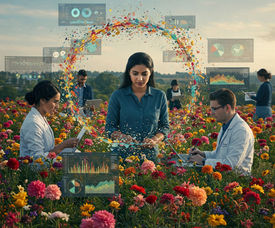The Algorithmic Guardian: AI in Workplace Safety and Well-being
- Tretyak
- 2 days ago
- 3 min read

The field of Human Resources is undergoing a profound transformation, driven by the integration of Artificial Intelligence (AI) technologies. One area where AI is having a particularly significant impact is in workplace safety and well-being. AI-powered tools are analyzing data, identifying risks, and providing insights to create a safer, healthier, and more supportive work environment, leading to a more productive, engaged, and resilient workforce.
1. Enhancing Workplace Safety: From Reactive to Proactive Risk Management
AI is playing a crucial role in enhancing workplace safety by shifting the focus from reactive measures to proactive risk identification and mitigation. This includes:
Predictive Risk Assessment: AI algorithms can analyze historical data on workplace incidents, such as accidents, injuries, and near misses, to identify patterns and predict potential future risks. This can include analyzing data on equipment failures, environmental hazards, and human behavior to identify high-risk areas and implement targeted interventions.
Real-Time Monitoring and Hazard Detection: AI-powered sensors and cameras can monitor workplace environments in real-time, identifying potential hazards and alerting safety personnel to potential risks. This can include detecting unsafe behavior, such as employees not wearing safety equipment, monitoring environmental conditions such as temperature and air quality, and identifying potential equipment failures.
Intelligent Safety Training and Simulations: AI-powered platforms can deliver engaging and interactive safety training programs, ensuring that employees are aware of safety procedures and best practices. This can include virtual reality simulations that allow employees to experience and practice safety procedures in a safe and controlled environment, gamified learning experiences that make safety training more engaging and memorable, and personalized training modules that cater to the specific needs and learning styles of individual employees.
2. Promoting Employee Well-being: From Reactive to Proactive Health Management
AI is also being used to promote employee well-being by identifying and addressing potential stress, burnout, and other mental health concerns, fostering a healthier and more sustainable work environment.
Proactive Employee Well-being Monitoring: AI can analyze employee data, such as work hours, communication patterns, performance data, and even wearable device data (with appropriate privacy considerations), to identify potential stress or burnout risks. This allows HR to intervene proactively and provide support to employees who may be struggling, such as offering additional support, connecting them with wellness resources, or adjusting their workload.
Personalized Wellness Programs: AI can personalize wellness programs based on individual employee needs and preferences. This can include recommending personalized fitness plans, providing access to meditation apps and mindfulness programs, and offering personalized nutrition advice.
Creating a Culture of Well-being: AI can help to create a culture of well-being by providing employees with the tools and resources they need to prioritize their health and well-being. This can include promoting healthy habits, such as exercise and healthy eating, providing access to wellness resources, and creating a supportive and inclusive work environment.
3. The Future of AI in Workplace Safety and Well-being: The Rise of the Algorithmic Guardian
The future of AI in workplace safety and well-being is bright, with ongoing advancements in machine learning, natural language processing, and other AI technologies. We can expect to see even more innovative applications that will further transform the way organizations protect and promote the well-being of their employees. This includes:
The Rise of AI-Powered Workplace Safety Platforms: AI-powered platforms that integrate a range of safety and well-being tools, providing a comprehensive and integrated approach to workplace safety and health. These platforms can collect and analyze data from various sources, identify risks, and provide real-time insights and alerts.
The Metaverse and Workplace Safety Training: The metaverse could revolutionize workplace safety training by providing immersive and interactive simulations that allow employees to experience and practice safety procedures in a virtual environment. This can create a more engaging and effective learning experience, improving employee safety awareness and compliance.
AI-Powered Employee Assistance Programs: AI-powered employee assistance programs that provide personalized support and guidance to employees struggling with mental health issues or other challenges. These programs can provide access to mental health resources, offer personalized coaching and support, and help employees to develop coping mechanisms and build resilience.
In conclusion, AI is playing a crucial role in enhancing workplace safety and promoting employee well-being, creating a safer, healthier, and more supportive work environment. As AI technologies continue to evolve, we can expect to see even more innovative applications that will further transform the way organizations protect and promote the well-being of their employees, leading to a more productive, engaged, and resilient workforce.































































































Comments